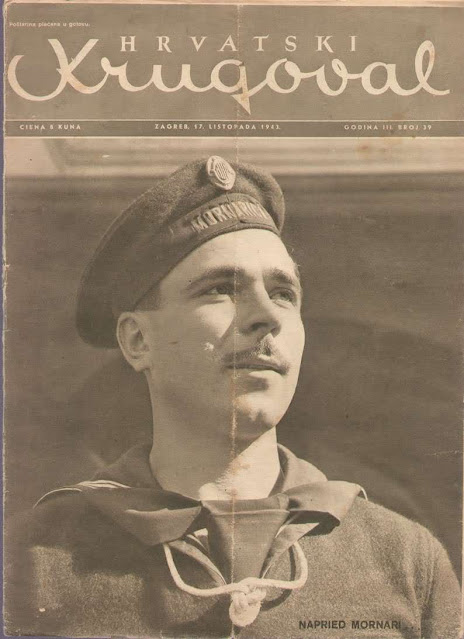Navy of the Independent State of Croatia
 |
| Naval Ensign of the Independent State of Croatia 1941 (from 1944 Naval Jack). |
The Navy of the Independent State of Croatia was the navy of the Independent State of Croatia during its existence. Right from the start, it was limited by the provisions of the Treaties of Rome and the Italian occupation of Dalmatia and Kvarner. Most of the navy spent the first half of the war on the eastern battlefield as the Croatian Naval Complex - the Black Sea. A somewhat better situation arose after the capitulation of Italy in 1943. However, the presence of a much stronger Kriegsmarine on the Adriatic ruled out the need for a separate Croatian navy, and the British navy and partisans dealt it heavy blows. After frequent desertions, the Germans abolished it and took over a small fleet. After 1943, it was called the Croatian Navy.
 |
| designation Navy of the Independent State of Croatia |
On April 18, 1941, a decision on
the organization of the army and navy of the Croatian Home Guard was published
in the Official Gazette. However, according to the Treaties of Rome, signed in
May, the NDH had to declare that it had no intention of holding a navy, ie
warships over 50 tons. Therefore, initially, the navy consisted of a river fleet
(river and river traffic) with headquarters in Zemun together with a battalion
of naval infantry and navy (coastal and naval-traffic) of several coastal
patrol ships, divided into three naval commands: North (base Crikvenica, later
Sušak), Središte (base Makarska, later Split) and Jug (base Dubrovnik).
 |
| Members of the Croatian Naval Legion, in the uniforms of the German Kriegsmarine, with the Croatian coat of arms on their sleeves |
The Croatian Naval Complex -
Black Sea (unofficially the Croatian Naval Legion) was a unit of the
Independent State of Croatia within the Kriegsmarine on the Black Sea. Its
establishment actually meant circumventing the avoidance of a ban on holding
the navy, at least to a very limited extent. It is stationed in Bulgaria and
Ukraine, first as the 23rd mine-lifting fleet and later as the 23rd submarine-hunting
fleet. On May 21, 1944, the last legionnaires returned to Croatia, and the
complex became the core of the new Adriatic Navy of the Independent State of
Croatia.

The cover of the newspaper Hrvatski krugoval with the sailor of the Independent State of Croatia
The Croatian fleet of submarine
hunters became famous for its honorable role of rescuing Jews from Romania and
the USSR, which is carried out and escorted to the security of Turkey.
After the capitulation of Italy
in September 1943, ships, infrastructure, ports, and facilities were taken over
by the Germans. The existing Adriatic Navy of the Independent State of Croatia
hastened to occupy better ports in Šibenik, Split, and elsewhere. On September
11, 1943, a unit of about 30 sailors under the command of the captain of the
battleship Matija Lenoch captured the Italian military cargo ship "San
Gi", which was moored in the port of Gruž with 5,000 tons of wheat. With
it, Italian soldiers tried to flee to Italy after the capitulation of Italy.
NDH sailors set sail, disarmed the Italians, and towed the ship back.
 |
| A 250t-class torpedo boat similar to T7, which was operated by the RMNDH in the Adriatic Sea between September 1943 and June 1944 when she was sunk |
At the beginning of November, a
corvette lieutenant Miren Blaž flew from Split to a seaplane to take over the
T-7 torpedo boat, while the motor sailing ship "Marjan" transferred
the naval detachment. T-7 was the only combat unit of the RM NDH for its
activities in Dalmatia.
RM NDH received from the Germans
five small KS-class torpedo boats, of which the Kroatische
Küsten-Schnellbootsflottille (Croatian Coastal Fast Fleet) was formed at the
end of September in Rijeka, which was subordinated to the German 11th Division.
The Germans planned to hand over two more torpedo boats, TA21 and TA35 to the
NDH navy, which did not materialize. The growing partisan navy and the complete
domination of the British navy in the Adriatic limited the combat value of the
NDH Navy.
 |
| The former Yugoslav monitor Morava was renamed Bosna and was part of the River Command Flotilla |
At the end of 1944, after the
liberation of Dalmatia, the navy consisted of a small flotilla stationed in
Rijeka. The entire flotilla tried to flee to the partisans on the night of
December 14, 1944, but all but one vessel (KS-5, on which he was the commander
of the flotilla) was stopped by the Germans. The Germans then disarmed the
vessels, included some in the Kriegsmarine, and sent the crews to Zagreb, where
they formed a special unit to fight on land. The commander of the TA48 torpedo
boat, the captain of the battleship Gjuro Štrcaj, and all the KS ships' commanders were brought before a military court for desertion and escape
plans but were declared innocent and acquitted. January 1, 1945, and the
separate RM NDH was officially liquidated, and the ships and their crews were
included in the Kriegsmarine. On the same day, the NDH flag was lowered on all
ships. At that time, the RM NDH had 139 officers, 152 non-commissioned officers, and 1,340 sailors with 437 other staff. On February 19, 1945, 7 patrol boats at
the Geesthacht shipyard near Hamburg, which were being built for the NDH, were
seized by the Germans and used to reinforce their Rhine fleet.





Comments
Post a Comment